
If you’re looking for a home with a larger floor space than your building site can afford, the logical solution is to build upwards. Multiple storeys do place pressure on your building frame though, requiring heavier loads to be supported and transferred down to the foundations. The complications of building higher above the ground will increase the price of framing. For most, a double storey home provides sufficient room. A three story home is not uncommon either, however homes with 4 or more storeys are more rare. Unless you're willing to install a lift in your home, too many storeys may become an inconvenience.
Framing materials
Some wall framing materials are more or less capable of supporting multiple storeys. While standard timber frames are safe for use up to a certain height, the number of storeys allowable depends on the individual design and engineering. Once the load bearing limit is reached with timber, alternative framing methods are necessary. Steel is currently the most popular choice for buildings with more than three or four storeys, due to its strength, durability and speed of construction. Concrete is also commonly used for frames in buildings with multiple storeys. Structural insulated panels and log frames can be used for multiple story dwellings, as can straw bale, mud brick and solid masonry frames.
Often a combination of timber, steel and other building materials is used. Again, any configuration of frame and framing materials can be used to build to any height as long as the design meets engineering requirements.
Stronger frames
When building a taller frame, there is a greater risk of walls succumbing to shear stress due to walls having a higher centre of gravity. This can cause walls to topple over. The frame will also need to resist the compressive stress from the heavier loads placed upon it. In order to combat shear and compressive pressure, the frame may be braced. Bracing can take the form of diagonal struts placed between wall studs, made from either steel or timber. Timber wall sills (the beams that rest on top of the struts) might be replaced with steel. Stronger fixings might need to be installed, along with sheathing with oriented strand board rather than weaker materials such as plywood.





